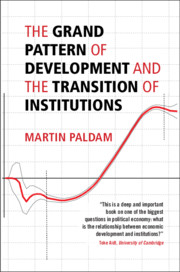Book contents
- The Grand Pattern of Development and the Transition of Institutions
- The Grand Pattern of Development and the Transition of Institutions
- Copyright page
- Contents
- Figures
- Tables
- Preface
- Part I Main Ideas
- Part II The Transitions of Institutions
- Contents
- Part IIA The Democratic Transition
- Contents
- 4 Literature, Data, Transition Path, and Causality
- 5 The Jumps Model for the Short Run
- 6 Events Are Practically Random
- 7 The Three Pillars Model for the Long Run
- Part IIB The Transition of the Economic System
- Part IIC The Transitions in Traditions and Beliefs
- Part III The Grand Transition
- References
- Index
6 - Events Are Practically Random
from Part IIA - The Democratic Transition
Published online by Cambridge University Press: 07 August 2021
- The Grand Pattern of Development and the Transition of Institutions
- The Grand Pattern of Development and the Transition of Institutions
- Copyright page
- Contents
- Figures
- Tables
- Preface
- Part I Main Ideas
- Part II The Transitions of Institutions
- Contents
- Part IIA The Democratic Transition
- Contents
- 4 Literature, Data, Transition Path, and Causality
- 5 The Jumps Model for the Short Run
- 6 Events Are Practically Random
- 7 The Three Pillars Model for the Long Run
- Part IIB The Transition of the Economic System
- Part IIC The Transitions in Traditions and Beliefs
- Part III The Grand Transition
- References
- Index
Summary
While the Jumps Model explains the changes caused by triggering events, Chapter 6 demonstrates that the events happen randomly. This is done in two ways: One is a statistical analysis trying to explain the binary event index. It appears that the standard development variables explain very little. The second is a study of the relevant articles in the Historical Archive of the Economist. One or more articles in the journal cover all 262 larger events found in the Polity P-index, 1960–2016. The articles all identify one (or more) triggering events. It appears that most are domestic political events. They are very diverse, so most have to be classified as practically exogenous. The second biggest causal factor is the external political event, associated to swings in the zeitgeist. System changes are independent of external economic events.
Keywords
- Type
- Chapter
- Information
- Publisher: Cambridge University PressPrint publication year: 2021

